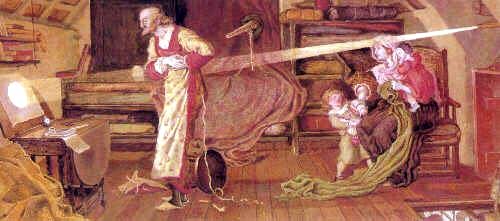CRABTREE'S VENUS-TRANSIT MEASUREMENT
Quarterly Jnl of the Royal Astr. Soc. 1991, 32, p.51

William Crabtree observing the same transit, by Ford Maddox Brown (permission of Manchester Town Hall)
To Allan Chapman's excellent account of the first observation of the transit of Venus (1) in your last issue, there is one fact which should be added : that is, the angular diameter of Venus at the time. Mr Chapman described how Jeremiah Horrocks recorded its size as 1' 12", while his colleague William Crabtree found it to be 1' 3", during the solar transit of November 24th, 1639 (Old Style). The actual angular diameter of Venus was then 1' 3" (2). Venus can never appear larger than 1' 6" in diameter.
Our sole record of the Crabtree measurement derives from Horrocks's memoir of the Venus-transit, which somewhat depicts it as having been hasty and less accurate than his own. He describes how, for Crabtree, the November sky had been overcast all day, until just before sunset when the Sun appeared. As the telescope projected the solar disk with its transiting image of Venus, Crabtree was supposedly awestruck
“rap't in contemplation he stood, motionless, scarce trusting his senses, through excess of joy.”
He missed the opportunity, because:
“In a little while, the clouds again obscured the face of the Sun, so that he could observe nothing more than that Venus was certainly on the disc at the time.”
Afterwards in recollection, Crabtree then made `so rapid a sketch' of Venus as it had passed across the Sun's disk.
Though admitting that Crabtree was `a person who has few superiors in mathematical learning', the young Horrocks seems to have wished to depict his colleague as one who rather missed the time available to map the transit accurately, and so had to sketch it from memory. This view would appear to require modifying if William Crabtree's measurement of Venus was precisely correct - remaining the most exact estimate of Venus' angular size for more than a century.
As Mr Chapman notes, what was surprising about these measurements was their small size, implying a scale of the solar system much larger than hitherto supposed. It is therefore of interest to note that, in the opinion of Sir Isaac Newton, as given in the third edition of his Principia which was composed nearly a century after these historic measurements were made, they were both too small:
Venus appeared to Mr Crabtrie only 1' 3"; to Horrox but 1' 12"; though by the mensurations of Hewelcke and Huygens without the sun's disc, it ought to have been seen at least 1' 24" (3).
REFERENCES
(1) Chapman, A., 199o. Jeremiah Horrocks, the transit of Venus, and the `New' Astronomy in early seventeenth-century England. Q. Jl R. asir. Soc., 31, 338.
(2) Computation kindly performed by Bernard Yallop of the Royal Greenwich Observatory.
(3) Isaac Newton, System of the World, Motte Translation, Vol. a, U.C.L.A. Press 1963, p. 565
The dawn of British astronomy: Jeremiah Horrocks observing the Venus transit of 1639 by
WR Lavender, 1903 (By permission of Astley Hall Museum, Chorley)
